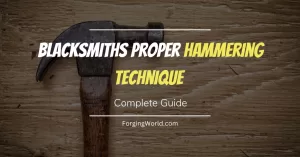I failed for the first couple of times trying to achieve proper fire with anthracite coal. It was so frustrating to experience. After some time, the fire would just cool down. Finally, I decided to go for advice from some experienced blacksmiths in my area. The major reason I was having is that I tried to maintain the fire as I would do with bituminous coal. Big mistake.
One of the easiest ways to start anthracite coal is to put charcoal or wood first and light it up. At this time, the air blow should be light. After you get a hot fire going you should gradually add anthracite coal. Because it needs a lot of air, now it is time to increase the air blow. You will notice that anthracite doesn’t produce as nearly smoke as bituminous coal.
Every fuel requires a different approach when it comes to fire management. The one size fits do not transfer to this. You have to adapt to a certain fuel, otherwise, it won’t work.
How to Manage Fire With Anthracite Coal?
Before even starting with fire, it is important to know the fundamental properties of the fuel you are working with. In this example, we are working with coal. During forging, coal goes through 4 phases.
Green coal—> Breeze—> Coke—> Clinker
Green coal is the starting point of any coal transformation where it is not burned yet. The most popular ones are anthracite and bituminous coal. Anthracite is considered as hard coal whereas bituminous as soft coal. Each type has its advantages and disadvantages. Anthracite has a unique shiny look, so sometimes it looks like some black glass.
As the green coal burns, it transforms into a breeze. It is green coal clumped together. Breeze is so light and soft that you could break it like nothing. Because of its combustibility, it can also serve as tinder for the fire.
After some time, the breeze eventually turns into coke. Coke is the thing in which you actually forge. Because of coke’s big surface area, it gives a lot of space for oxygen to react with and therefore, achieves high temperatures. It is also light but much denser than a breeze.
Clinkers are the waste product of burning coal. They are occurring typically between conversion from breeze to coke and build up around the air grate. Clinkers have no use in blacksmithing.
Lighting a fire
I should note that the forge should be all cleaned up before starting a new fire. A huge build-up of clinkers and other waste products will make it nearly impossible to light it. So, when all that is set and done, you are ready to start a fire.
Sometimes, lighting anthracite coal will take patience and time. One of the most effective ways to light anthracite coal is with charcoal. You should simply put together a few pieces of charcoal and light it with a torch or lighter. After that, the air blower should be turned on slowly. At this time you don’t want a strong air blow. Charcoal is very combustible so it burns quickly.
Once the hot and well-established fire is achieved, it is time to gradually add anthracite coal. At this moment, the air blow should be increased. This was my biggest mistake when I was desperately trying to light it. I treated the same anthracite as bituminous coal. It just doesn’t work that way. Anyway, let’s move on.
The ideal size of anthracite would be either pea or nut size. You will hear a popping sound when you throw fresh anthracite coal into hot fire. Once the first layer turns orange, add another one. If you add too much anthracite, the fire could be smothered, and then the whole process must be repeated.
After a few minutes as the fire spreads, you will notice that anthracite produces much taller flames than bituminous. Another thing you may notice is that anthracite coal is much less smokey than bituminous.
Extuingishing a fire
The simplest way to cool down a coal fire is to just throw a cold bucket of water over it. This could cause damage to the firepot in the long term, so we will use longer, but much safer ways to extinguish it.
To properly extinguish a coal fire, the first and most obvious thing to do is to turn off the air blower. Second, you should remove the green coal from the burning coal, so the fire does not catch it again. After that, the center of the fire should be spread. Otherwise, it will hold heat much longer.
The next step would be to dig up coal beneath and place it aside. Now it is a good time to remove clinkers that accumulated during forging. This whole process could take for about 1 hour or so. A good thing about anthracite is that it cools down quickly so the extinguishing could last even less.
Related Questions
What Temperature Does Anthracite Coal Burn At?
Anthracite has been exposed to the most pressure and heat, making it the hardest type of coal you can find. Anthracite coal can produce more heat than bituminous due to its density and hardness. It produces a very tall, blue flame. In regards to producing heat, anthracite wins over bituminous coal but the downside is that it cools much quicker.
Typically, anthracite coal can achieve temperatures roughly over 900 degrees. On average, it produces 12,500 Btu/lb. It usually contains less than 10% of volatile content and somewhere between 92-98 % of carbon content on an ash-free basis. It is also known for its clear burning.
Is Anthracite Coal Safe to Burn?
Anthracite is considered one of the safest fossil fuels to use. Its low sulfur content makes it an incredibly clean-burning fuel as it produces almost no smoke or emissions. Compared to other types of fuels, anthracite is much safer to use in home workshops.
As with any fuel, safety equipment is needed. When working with coal, wearing safety glasses and respirators will greatly reduce the chance of any possible hazard. Always wear old clothes because blacksmithing is a hobby that can be very messy.
Can I Burn Coal and Wood Together?
Not only that you can burn coal and wood together, but it is recommended to put them together. For example, if you would try to directly light coal with a lighter, it would hardly work. Coal has to be added in already a well-established fire, and the easiest way to do it is with wood or charcoal. So, you would use wood to start the fire and add coal after.
I would say that charcoal is superior to wood in this regard. Simply said, charcoal is burned wood. It is almost pure carbon which allows it to burns much hotter.



